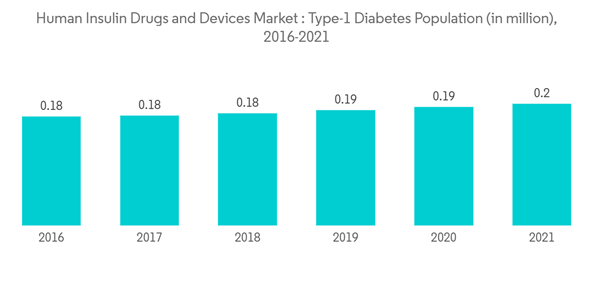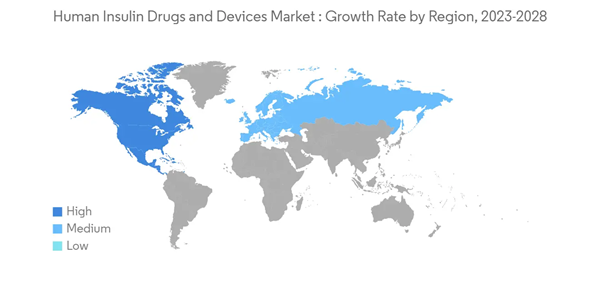The Human Insulin Drugs and Delivery Devices Market size is estimated at USD 67.45 billion in 2024, and is expected to reach USD 80.99 billion by 2029, growing at a CAGR of 3.73% during the forecast period (2024-2029).
Diabetes mellitus is considered a risk factor for increasing COVID-19. During the COVID-19 pandemic, tight control of glucose levels and prevention of diabetes complications might be crucial in patients with diabetes mellitus to keep susceptibility low and to prevent severe courses of COVID-19. COVID-19 affects glucose metabolism, mainly in patients with diabetes due to this frequent usage of insulin drugs and delivery devices market increased.
Diabetes is generally considered a lifestyle-related disease. Over time, with the increase in population around the world, the incidences of the disease have increased outrageously. Approximately 100 million people around the world need insulin, including all the people suffering from Type 1 diabetes and between 10-25% of people with Type 2 diabetes. Although insulin has been used in the treatment of diabetes for over 90 years, globally, more than half of those who need insulin today still cannot afford and access it. Insulin Drugs and delivery devices are necessary for type-1 diabetes patients because their body doesn't produce insulin internally, type-2 diabetes patients also need insulin, particularly those who have difficulty controlling their diabetes with oral medications.
The exact cause of type-1 diabetes is unknown, but type-2 diabetes is caused by day-to-day lifestyle changes and choices. The prevalence rate of type-2 diabetes has quadrupled when compared to a decade ago. The prevalence of type-1 diabetes mellitus (T2DM) has increased dramatically during the last two decades, a fact driven by the increased incidence of obesity, the primary risk factor for T1DM. Diabetes ranks among the fastest-growing chronic diseases in the United States. India is among the top three countries with a high incidence of diabetes. Many reports and surveys have documented a drastic increase in the diabetic population based on lifestyle habits.
Although oral anti-diabetic drugs are considered a standard of care for type-2 diabetes patients, there has been a rise in the need for using insulin, along with conventional medication, to help stabilize blood glucose levels. This trend has attracted many players, both local and international, to enter the biosimilar market.
The R&D in the insulin segment is rising year-on-year as researchers are trying to bring out the best molecule for patients' use, curb maximum side effects, and increase their efficiency. Thus, the increasing prevalence of obesity and diabetes across the world is likely to augment the demand for insulin, which in turn drives the market for insulin drugs and devices.
Despite all these factors, the market for insulin drugs and delivery devices is high in North America because there is no other major option other than insulin. There have been several initiatives carried out in the commercial sector to address insulin affordability. The recent advent of biosimilar insulin products may help reduce out-of-pocket costs, as could the possibility of automatic interchangeability between biosimilar insulin and originator products.
Thus, owing to the above factors, it is expected to drive market growth over the forecast period.
This product will be delivered within 2 business days.
Diabetes mellitus is considered a risk factor for increasing COVID-19. During the COVID-19 pandemic, tight control of glucose levels and prevention of diabetes complications might be crucial in patients with diabetes mellitus to keep susceptibility low and to prevent severe courses of COVID-19. COVID-19 affects glucose metabolism, mainly in patients with diabetes due to this frequent usage of insulin drugs and delivery devices market increased.
Diabetes is generally considered a lifestyle-related disease. Over time, with the increase in population around the world, the incidences of the disease have increased outrageously. Approximately 100 million people around the world need insulin, including all the people suffering from Type 1 diabetes and between 10-25% of people with Type 2 diabetes. Although insulin has been used in the treatment of diabetes for over 90 years, globally, more than half of those who need insulin today still cannot afford and access it. Insulin Drugs and delivery devices are necessary for type-1 diabetes patients because their body doesn't produce insulin internally, type-2 diabetes patients also need insulin, particularly those who have difficulty controlling their diabetes with oral medications.
Human Insulin Drugs and Delivery Devices Market Trends
Type-1 Diabetes Population Driving the Market In The Forecast Period
The type-1 diabetes population is expected to register a CAGR of over 2% during the forecast period.The exact cause of type-1 diabetes is unknown, but type-2 diabetes is caused by day-to-day lifestyle changes and choices. The prevalence rate of type-2 diabetes has quadrupled when compared to a decade ago. The prevalence of type-1 diabetes mellitus (T2DM) has increased dramatically during the last two decades, a fact driven by the increased incidence of obesity, the primary risk factor for T1DM. Diabetes ranks among the fastest-growing chronic diseases in the United States. India is among the top three countries with a high incidence of diabetes. Many reports and surveys have documented a drastic increase in the diabetic population based on lifestyle habits.
Although oral anti-diabetic drugs are considered a standard of care for type-2 diabetes patients, there has been a rise in the need for using insulin, along with conventional medication, to help stabilize blood glucose levels. This trend has attracted many players, both local and international, to enter the biosimilar market.
The R&D in the insulin segment is rising year-on-year as researchers are trying to bring out the best molecule for patients' use, curb maximum side effects, and increase their efficiency. Thus, the increasing prevalence of obesity and diabetes across the world is likely to augment the demand for insulin, which in turn drives the market for insulin drugs and devices.
North America is Expected to Dominate the Human Insulin Drugs and Delivery Devices Market.
North America dominates the human insulin drug and delivery device market, despite having high insulin prices. According to RAND researchers, insulin drug companies charge more for insulin in the United States than in any other country. Insulin drug companies say that the price is based on government regulations and insurance providers. For the insured, out-of-pocket costs are usually calculated as a percentage of co-insurance of the list price of insulin products. Increases in patient co-insurance, therefore, reflect rising list prices of insulin products. According to a Commonwealth Fund study, uninsured Americans with diabetes are more likely to be using older, less costly (and less effective) insulin drugs compared to those with private insurance or Medicaid. 60% to 80% of uninsured patients pay the full list price for insulin, while 9% of privately insured patients and 3% of Medicaid beneficiaries do.Despite all these factors, the market for insulin drugs and delivery devices is high in North America because there is no other major option other than insulin. There have been several initiatives carried out in the commercial sector to address insulin affordability. The recent advent of biosimilar insulin products may help reduce out-of-pocket costs, as could the possibility of automatic interchangeability between biosimilar insulin and originator products.
Thus, owing to the above factors, it is expected to drive market growth over the forecast period.
Human Insulin Drugs and Delivery Devices Industry Overview
The market is highly consolidated, with three major manufacturers holding a global market presence and the remaining manufacturers confined to other local or region-specific manufacturers. Mergers and acquisitions that happened between the players in the recent past have helped the companies strengthen their market presence. Eli Lilly and Boehringer Ingelheim have an alliance to develop and commercialize Basaglar (Insulin Glargine). Additionally, the players in the recent past helped the companies strengthen their market presence; for example, Novo Nordisk collaborated with Ypsomed to provide better insulin therapy solutions.Additional Benefits:
- The market estimate (ME) sheet in Excel format
- 3 months of analyst support
This product will be delivered within 2 business days.
Table of Contents
1 INTRODUCTION
4 MARKET DYNAMICS
5 MARKET SEGMENTATION
6 MARKET INDICATORS
7 COMPETITIVE LANDSCAPE










